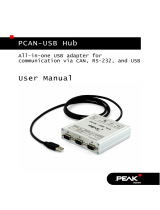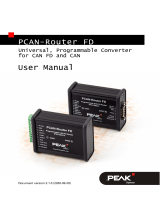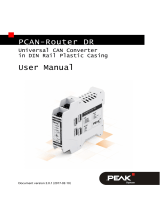Page is loading ...

PCAN-Router Pro FD
6-Channel CAN FD Router with I/O and
Data Logger
User Manual
Document version 1.1.0 (2020-01-30)

PCAN-Router Pro FD – User Manual
2
Relevant products
Product name Model Part number
PCAN-Router Pro FD
IPEH-002220
PCAN is a registered trademark of PEAK-System Technik GmbH. Eclipse® is a
trademark of the Eclipse Foundation, Inc. BroadR-Reach® is a trademark of
Broadcom Corporation. CANopen® and CiA® are registered trademarks of CAN in
Automation e.V.
All other product names in this document may be the trademarks or registered trade-
marks of their respective companies. They are not explicitly marked by ™ or ®.
© 2020 PEAK-System Technik GmbH
Duplication (copying, printing, or other forms) and the electronic distribution of this
document is only allowed with explicit permission of PEAK-System Technik GmbH.
PEAK-System Technik GmbH reserves the right to change technical data without
prior announcement. The general business conditions and the regulations of the
license agreement apply. All rights are reserved.
PEAK-System Technik GmbH
Otto-Roehm-Strasse 69
64293 Darmstadt
Germany
Phone: +49 (0)6151 8173-20
Fax: +49 (0)6151 8173-29
www.peak-system.com
info@peak-system.com
Doc
ument version 1.1.0 (2020-01-30)

PCAN-Router Pro FD – User Manual
3
Contents
1 Introduction 5
1.1 Properties at a Glance 5
1.2 Operation Requirements 7
1.3 Scope of Supply 7
2 Connectors 8
2.1 Power Supply 9
2.2 CAN over D-Sub Connectors 10
2.3 Inputs and Outputs (I/O) 10
2.4 Status LEDs 11
2.5 USB Connection 11
2.6 SD Card Slot 11
3 Operation 12
3.1 Ensuring Power Supply 12
3.2 Starting the PCAN-Router Pro FD 12
4 Hardware Modifications 13
4.1 Using Alternative Transceiver Module 13
4.2 Setting the Termination for a CAN Bus 15
4.3 Changing the Button Cell for the Real-Time
Clock (RTC) 16
4.4 Installing Backup Battery 18
5 Creating Own Firmware 20
5.1 Installation Development Environment 20
5.2 Creating a New Project in Eclipse 22
6 Firmware Upload 25
6.1 System Requirements 25

PCAN-Router Pro FD – User Manual
5
1 Introduction
With six channels, the PCAN-Router Pro FD links the data traffic of
modern CAN FD and classic CAN buses. Pluggable CAN transceiver
modules allow flexible adaptation of each CAN channel to the
respective requirements. In addition, the router is equipped with an
analog input and four digital I/Os.
The CAN messages can be recorded on the internal memory or on
an inserted memory card and later read out via the USB connection.
With the PCAN-Router Pro FD the data flow of test benches and
production plants can be managed, monitored, and controlled. The
conversion from CAN to CAN FD or vice versa enables the
integration of new CAN FD applications into existing CAN 2.0
networks.
The behavior of the PCAN-Router Pro FD can be programmed freely
for specific applications. The firmware is created using the included
development package with GNU compiler for C and C++ and is then
transferred to the module via CAN. Various programming
examples, such as message forwarding or recording, facilitate the
implementation of own solutions.
1.1 Properties at a Glance
6 High-speed CAN channels (ISO 11898-2)
Complies with CAN specifications 2.0 A/B and FD
CAN FD support for ISO and Non-ISO standards
CAN FD bit rates for the data field (64 bytes max.) from 40
kbit/s up to 12 Mbit/s
CAN bit rates from 40 kbit/s up to 1 Mbit/s
NXP CAN transceiver TJA1043 with Wake-up

PCAN-Router Pro FD – User Manual
6
Alternative plugable transceiver modules on request
(details on page 13)
CAN connections are D-Sub, 9-pin
CAN termination switchable, separately for each CAN channel
Wake-up function using separate input, CAN bus, or real-time
clock
2 digital I/Os, each usable as digital input or output with High-
side switch
2 digital I/Os, each usable as digital input or output with Low-
side switch
1 analog input (0 - 33 V)
Recording of CAN data and error frames
Internal memory: 16 GByte pSLC eMMC
SD card slot for additional memory
USB connection for accessing the data memory (e.g. recorded
log data)
Conversion of logging data to various output formats using the
Windows software PEAK-Converter
Battery-buffered real-time clock (RTC), can also be used for
wake-up
Beeper
Status LEDs for CAN channels, memory cards, and power
supply
Microcontroller STM32F765NIH6 (based on Arm® Cortex® M7)
32 MByte SDRAM in addition to microcontroller RAM
Aluminum casing with flange

PCAN-Router Pro FD – User Manual
7
8 - 32 V power supply, protection against overvoltage and
reverse polarity
Slot for a backup battery for defined switch-off behavior (e.g. for
log data saving)
Optional on request:
Ethernet interface via RJ-45 socket or BroadR-Reach® interface
via D-Sub connector
Extended operating temperature range from -40 to 85 °C
(-40 to 185 °F)
1.2 Operation Requirements
The transfer of the firmware via CAN requires a PEAK CAN
interface
1.3 Scope of Supply
PCAN-Router Pro FD in aluminum casing including mating
connectors for I/O and power
USB connector cable
Windows development package with GCC ARM Embedded,
flash program, and programming examples
Conversion software PEAK-Converter for Windows 10, 8.1, 7
(32/64-bit)
Manual in PDF format

PCAN-Router Pro FD – User Manual
8
2 Connectors
This chapter describes the connections on the front panel of the
PCAN-Router Pro FD.
Figure 1: Pin assignment on the front panel of the PCAN-Router Pro FD
Figure 2: Description of the pin assignments on the top of the housing

PCAN-Router Pro FD – User Manual
9
2.1 Power Supply
For the operation of the PCAN-Router Pro FD a voltage source with
nominal 12 V DC is required, 8 to 32 V are possible. The input is
electronically protected with reverse polarity and overvoltage
protection.
Note: The scope of delivery does not include a power supply
unit for the power supply of the device. The device is not
supplied via the USB connection to the PC.
The connection is made via the mating connector supplied (3-pole,
type: Phoenix Contact MC1,5/2-STF-3,81) to which you can screw
cable strands. The polarity is as follows:
Figure 3: Power connector
Pin Function Description
1 Wake-Up Wake-up signal
2 V
b
(8-32V) Power supply
with 8 to 32 V DC
3 GND Ground
Pin 1 is only necessary for transceivers without wake-up function
(see section 4.1) to switch on the device.

PCAN-Router Pro FD – User Manual
10
2.2 CAN over D-Sub Connectors
A high-speed CAN bus (ISO 11898-2) is connected to the 9-pin D
Sub connector. The CAN assignment corresponds to the CiA® 303-1
specification.
Figure 4: Pin assignment High-speed CAN
2.3 Inputs and Outputs (I/O)
The I/O connector has 4 digital inputs and outputs and one analog
input. The connection is made via the supplied mating connector (6-
pin, type: Phoenix Contact MC1.5/2-STF-3.81), to which you can
screw cable strands.
Figure 5: I/O connector
Pin Name Function
1 Digital In/Out 1 Digital input and output 1 (high-side)
2 Digital In/Out 2 Digital input and output 2 (high-side)
3 Digital In/Out 3 Digital input and output 3 (low-side)

PCAN-Router Pro FD – User Manual
11
Pin Name Function
4 Digital In/Out 4 Digital input and output 4 (low-side)
5 GND Ground
6 Analog In 1 Analog input 1
2.4 Status LEDs
When a power supply is applied, the power LED lights up green. All
other LEDs can be programmed with their own firmware. More
details can be found in the supplied C code examples.
2.5 USB Connection
The internal memory and the external SD card of the PCAN-Router
Pro FD can be accessed via a USB connection with a PC. The
operating system on the PC integrates the memory card into the file
management, for example as a mass storage device under
Windows. Only FAT 32 is supported as the file system for the
internal and external storage medium. Via the USB connection, for
example, stored traces files can be accessed.
Note: Access to the USB connection via the CPU is not
possible.
2.6 SD Card Slot
Optionally, a memory card can be inserted into the SD card slot.
The SD card can be accessed via the USB connection.

PCAN-Router Pro FD – User Manual
12
3 Operation
3.1 Ensuring Power Supply
The PCAN-Router Pro FD must be supplied as standard with a
nominal 12 V (8 to 32 V possible) DC voltage via the power
connection.
Note: If you install a backup battery (see section 4.4) and it is
charged, the device can also be operated without a power
supply (e.g. in the event of a power failure).
3.2 Starting the PCAN-Router Pro FD
The PCAN-Router Pro FD is automatically switched on when the
supply voltage is applied (power LED lights up). By default, six
transceiver modules with wake-up function
are installed.
If other transceiver modules without wake-up function
are installed
on request, an external wake-up signal via pin 1 of the power
connector is required (see section 4.1 on page 13).

PCAN-Router Pro FD – User Manual
13
4 Hardware Modifications
You can make various hardware adjustments on the board of the
PCAN-Router Pro FD:
Using an alternative CAN Transceiver module (section 4.1)
Adapting the termination for a CAN bus (section 4.2)
Changing the button cell for the real-time clock (section 4.3)
4.1 Using Alternative Transceiver Module
An alternative CAN transceiver module can be used for each of the
six CAN connections. The PCAN-Transceiver TJA1043 is preinstalled
by default. The following alternative modules are supported:
Order
number
Name Transmission
standard
Bit rate Wake-
up
Galvanic
isolation
IPEH-001001
PCAN-Transceiver
TJA1041
High-Speed-CAN
ISO 11898-2
40 kbit/s to
1 Mbit/s
yes no
IPEH-001002
PCAN-Transceiver
PCA82C251
High-Speed-CAN
ISO 11898-2
0 kbit/s to
1 Mbit/s
no no
IPEH-001004
PCAN-Transceiver
TH8056
Single-Wire-CAN
SAE J2411
1.3 kbit/s
to 40 or
100
kbit
/
s
yes no
IPEH-001005
PCAN-Transceiver
TJA1055
Low-Speed-CAN
ISO 11898-3
20 kbit/s to
125 kbit/s
yes no
IPEH-001006
PCAN-Transceiver
TJA1044
High-Speed-CAN
ISO 11898-2
25 kbit/s to
12 Mbit/s*
no no
IPEH-001007 PCAN-Transceiver
TJA1044-ISO
High-Speed-CAN
ISO 11898-2
25 kbit/s to
12 Mbit/s*
no yes
IPEH-001008
Default
PCAN-Transceiver
TJA1043
High-Speed-CAN
ISO 11898-2
40 kbit/s to
12 Mbit/s*
yes no
* According to the CAN transceiver data sheet only CAN FD bit rates up to 5 Mbit/s are
guaranteed with the specified timing.

PCAN-Router Pro FD – User Manual
14
Figure 6: Positions of the transceiver modules for the six CAN FD channels
Do the following to change a transceiver module:
1. Disconnect the device from the power supply.
2. Remove the two upper screws on the front and back of the
housing.
3. BroadR-Reach® interface only:
Remove the mounting screws of the D-Sub connector on the
back of the housing.
4. Pull out the housing cover.
5. Only with backup battery installed:
Remove the backup battery.
6. Remove the screw on the board from the transceiver
module to be replaced.
7. Remove the module from the front panel slot.
8. Plug the new transceiver module into the slot.
9. Fasten the module again with the screw.
10. Only with backup battery installed:
Reinstall the backup battery and secure it with a cable tie.
11. Insert the housing cover.
12. Fasten the four screws to the front and rear of the housing.

PCAN-Router Pro FD – User Manual
15
When the PCAN-Router Pro FD is restarted, it automatically detects
the type of CAN transceiver module used and sets the transmission
standard (see table above) for the CAN channel accordingly.
Note: If one or more transceiver modules without wake-up
function are installed in an adapted configuration, an external
wake-up signal via pin 1 of the power connector is required.
Only then will the device or the respective transceiver be
powered on.
4.2 Setting the Termination for a CAN Bus
Depending on the CAN transceiver module used, you can use the
switch blocks to set a CAN bus termination for the respective CAN 1
to CAN 6 (C1 to C6) connection. On delivery, the switch blocks are
set to off.
Tip: We recommend to do termination at the CAN cabling, for
example with termination adapters (e.g. PCAN-Term). Thus,
CAN nodes can be flexibly connected to the bus.
Figure 7: Positions of the switch blocks for CAN termination on the front board

PCAN-Router Pro FD – User Manual
16
Termination at switch position Type of transceiver
Off On
High-speed-CAN (ISO 11898-2)
Transceiver installed by default.
none
120 between
CAN_L and CAN_H
Low-speed-CAN (ISO 11898-3)
Transceiver only on request.
4.7 k for
CAN_L and CAN_H
1.1 k for
CAN_L and CAN_H
Single-Wire-CAN (SAE J2411)
Transceiver only on request.
9.1 k for CAN_SW 2.1 k for CAN_SW
Attention! Electrostatic discharge (ESD) can damage or destroy
components on the card. Take precautions to avoid ESD.
Do the following to activate the CAN termination:
1. Disconnect the device from the power supply.
2. Remove the two upper screws on the front and back of the
housing.
3. Pull out the housing cover.
4. Use a slotted screwdriver and set the switch of the desired
CAN channel from off to on.
5. Insert the housing cover.
6. Fasten the four screws to the front and back of the housing.
4.3 Changing the Button Cell for the Real-
Time Clock (RTC)
The real-time clock (RTC) installed in the PCAN-Router Pro FD is
supplied by a button cell of the IEC type CR1620 (3 V) as long as the
device is switched off (without power supply).

PCAN-Router Pro FD – User Manual
17
Figure 8: Position of the button cell for the real-time clock on the main board
A new button cell lasts several years. If the internal clock indicates
an unexpected time, remove the button cell and measure its
voltage. The nominal voltage is 3.0 volts. If the measured voltage is
lower than 2.5 volts, replace the button cell.
Attention! Electrostatic discharge (ESD) can damage or destroy
components on the card. Take precautions to avoid ESD.
Do the following to replace the button cell:
1. Disconnect the device from the power supply.
2. Remove the two upper screws on the front and back of the
housing.
3. Pull out the housing cover.
4. Only with backup battery installed:
Remove the backup battery before replacing the button cell.
5. Carefully remove the button cell from the holder.

PCAN-Router Pro FD – User Manual
18
6. Insert the new button cell.
7. Only with backup battery installed:
Replace the backup battery.
8. Insert the housing cover.
9. Fasten the four screws to the front and back of the housing.
4.4 Installing Backup Battery
On the board of the PCAN-Router Pro FD a backup battery in the
form factor 18650 can be inserted, which must be protected against
short circuit, overcharging, and deep discharge (Protection PCB).
Thus, operation can be ensured during a power failure (power LED
off).
The recharging of the backup battery must be programmed. A code
example (C/C++) of this can be found in the supplied development
package.
Figure 9: Position of the backup battery on the board

PCAN-Router Pro FD – User Manual
19
Attention! Electrostatic discharge (ESD) can damage or destroy
components on the card. Take precautions to avoid ESD.
Do the following to install the backup battery:
1. Disconnect the device from the power supply.
2. Remove the eight screws at the front and back of the
housing.
3. Only with optional BroadR-Reach® interface:
Remove the two fastening screws of the D-Sub connector
on the rear of the housing.
4. Remove the back panel and housing cover.
5. Pull the board out of the housing in the direction of the front
side.
6. Insert the backup battery with integrated protection (form
factor 18650) according to the polarity.
7. Fasten the battery with a cable tie in the recesses provided.
8. Push the board back into the first rail of the housing.
9. Replace the housing cover and the back panel.
10. Only with optional BroadR-Reach® interface:
Fasten the two screws of the D-Sub connector to the rear of
the housing.
11. Reinsert all eight housing screws.
Important note: Only use batteries with integrated PCB
protection to avoid short circuit, overcharging, and deep
discharge! We recommend using a lithium-ion battery such as
the Soshine 18650 3600 mAh 3.7 V or comparable models.

PCAN-Router Pro FD – User Manual
20
5 Creating Own Firmware
In this section all necessary steps are described to import, execute,
and use an example from the development package of PEAK-
System in Eclipse in new projects. Eclipse is only one of many ways
to create your own firmware.
Important note: We do not provide support for Eclipse or the
Java Runtime.
Requirements:
PCAN-Router Pro FD development package that includes the
following:
Sample files
Build tools
GNU Embedded Toolchain for Arm
Java™ SE Development Kit 8, Update 201
Eclipse (version 4.10.0)
GNU MCU Plug-in from Eclipse Marketplace
5.1 Installation Development Environment
Development package
1. Download the development package to your computer.
2. Click here
to start the download.
3. Unzip the zip file.
/







